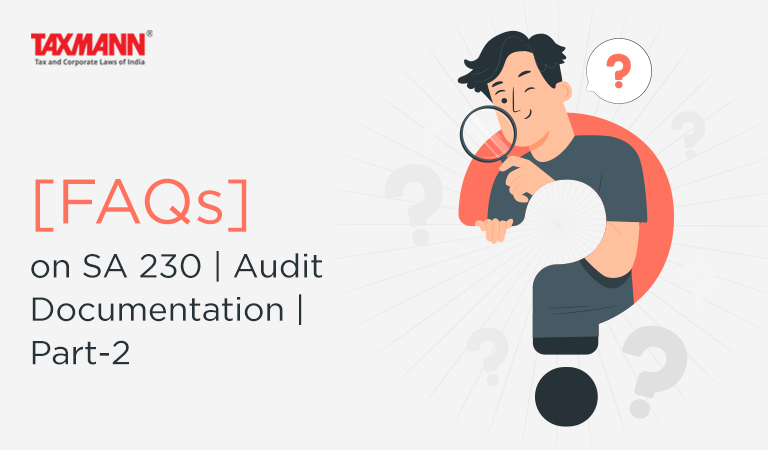[FAQs] on SA 230 | Audit Documentation | Part-2
- News|Blog|Account & Audit|
- 2 Min Read
- By Taxmann
- |
- Last Updated on 10 March, 2023
Audit documentation is considered the backbone of an audit. The work that the auditor performs, the explanations given to the auditor and the conclusions arrived at, all are evidenced by documentation. SA 230 deals with the responsibility of the auditor to prepare audit documentation for an audit of financial statements. The objective behind the preparation of the audit documentation provides:
(a) a sufficient and appropriate record of the basis for the auditor’s report;
(b) evidence that the audit was planned and performed in accordance with the SAs and applicable legal and regulatory requirements.
To make it easier to understand the stipulations under SA 230, the standard has been broken down into a Q&A format.
FAQ 1. What should the auditor record in documenting the nature, timing and extent of audit procedures performed?
SA 220 requires the auditor to review the audit work performed through review of the audit documentation. The requirement to document the reviewer of audit work does not mean that every working paper needs to include review evidence. Instead, it implies documenting which audit work was reviewed, who reviewed it, and the review date. This documentation ensures adequate review and oversight of the audit work, ensuring the accuracy and reliability of the audit results.
FAQ 2. What will the auditor do when it is necessary to depart from a relevant requirement in a SA?
When departing from a relevant requirement in a SA, the auditor should document the alternative audit procedures performed, how they accomplish the objective, and the rationale behind the departure. The requirements outlined in SAs are intended to help auditors achieve their objectives, including the overall goal of the audit. As a result, compliance with relevant requirements outlined in the SAs is typically required unless there are exceptional circumstances warranting a departure.
FAQ 3. When an auditor discovers information that conflicts with their final conclusion about a significant matter, what documentation should they prepare?
According to para 11 of SA 230, if the auditor identifies information that conflicts with their final conclusion on a significant matter, they must document how they addressed the inconsistency. However, this does not mean that the auditor needs to keep documentation that is outdated or incorrect.
FAQ 4. When should the auditor complete the administrative process of assembling the final audit file?
The timely completion of the assembly of the final audit file is important and should be done in accordance with the policies and procedures established by the firm as required by SQC 1. Generally, the auditor should aim to complete the assembly of the final audit file within 60 days of the date of the auditor’s report.
Click Here To Read The Full Story
Disclaimer: The content/information published on the website is only for general information of the user and shall not be construed as legal advice. While the Taxmann has exercised reasonable efforts to ensure the veracity of information/content published, Taxmann shall be under no liability in any manner whatsoever for incorrect information, if any.

Taxmann Publications has a dedicated in-house Research & Editorial Team. This team consists of a team of Chartered Accountants, Company Secretaries, and Lawyers. This team works under the guidance and supervision of editor-in-chief Mr Rakesh Bhargava.
The Research and Editorial Team is responsible for developing reliable and accurate content for the readers. The team follows the six-sigma approach to achieve the benchmark of zero error in its publications and research platforms. The team ensures that the following publication guidelines are thoroughly followed while developing the content:
- The statutory material is obtained only from the authorized and reliable sources
- All the latest developments in the judicial and legislative fields are covered
- Prepare the analytical write-ups on current, controversial, and important issues to help the readers to understand the concept and its implications
- Every content published by Taxmann is complete, accurate and lucid
- All evidence-based statements are supported with proper reference to Section, Circular No., Notification No. or citations
- The golden rules of grammar, style and consistency are thoroughly followed
- Font and size that’s easy to read and remain consistent across all imprint and digital publications are applied








 CA | CS | CMA
CA | CS | CMA


